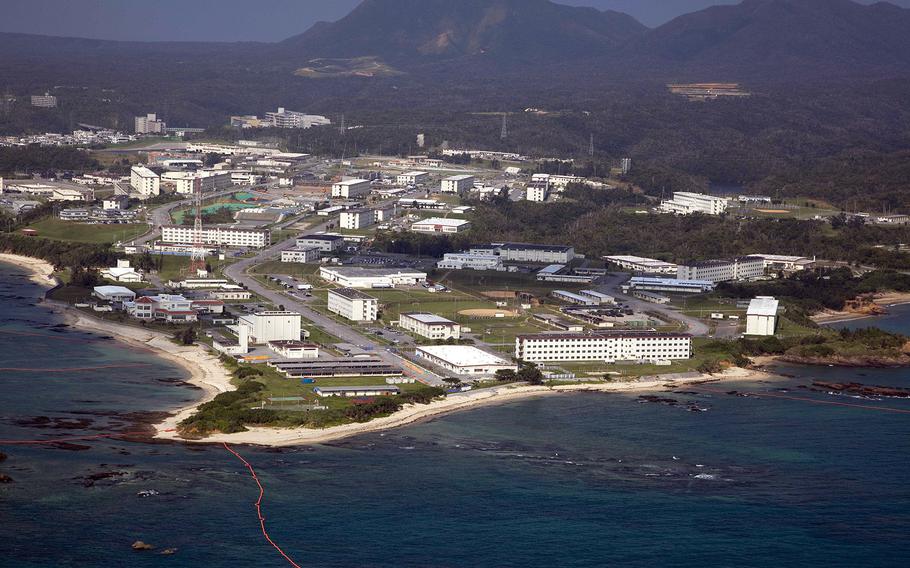
An aerial view of Camp Schwab. The Japanese government plans to suspend ongoing preparation for a new runway at Camp Schwab after Gov. Takeshi Onaga threatened to revoke the authorization for landfill work. (III Marine Expeditionary Force)
CAMP FOSTER, Okinawa — The Japanese government plans to suspend ongoing preparation for a new runway at Camp Schwab in Okinawa’s remote north after Gov. Takeshi Onaga threatened to revoke the authorization for landfill work.
Chief Cabinet Secretary Yoshihide Suga said Tuesday that the work will cease between Aug. 10 and Sept. 9. During that time, the Japanese government will allow prefectural authorities to enter the restricted construction area and see how much damage has been caused to coral by heavy concrete blocks placed at the site.
Government officials will once again meet with Onaga for “intensive discussions” about the plan.
Although the suspension would appear to be a major victory for the island prefecture’s fervent protest movement, which has held vigil at the site and grown increasingly vitriolic in recent months, Suga said the Japanese position on the runway has not changed. The runway will facilitate the closing and relocation of Marine Corps Air Station Futenma from a densely populated urban area in central Okinawa.
“The government will once again explain to Okinawa the position where the government stands,” Suga said. “During the intensive discussions, the government would thoroughly explain to Okinawa the need for removal of danger posed at Futenma air station, as well as visible reduction in the burden of Okinawa related to the presence of the military.”
Suga said he would also listen to Okinawan authorities on the matter. When asked Tuesday, Onaga said that the decision was a positive step forward.
“I feel that our voices have been finally heard,” Onaga said. “I will spare no effort if the dialogue will help break the ice for a solution to this problem.”
Japan’s announcement comes on the heels of a third-party report, commissioned by Onaga, that reportedly found legal flaws in the decision making and authorization process of his predecessor, Gov. Hirokazu Nakaima, who approved the project. Suga did not address the report specifically in his comments.
The Futenma relocation morass dates back to 1995, when two Marines and a Navy Corpsman kidnapped and brutally raped a 12-year-old girl. During the protests that followed, residents called for the shuttering and relocation of the Marine Corps air base.
The move was agreed upon during bilateral negotiations a year later. However, much to the consternation of locals, it was decided that the operations would be kept within the island prefecture.
The two governments settled on Schwab in 1997. Efforts intensified in 2004 after a CH-53D Sea Stallion from Futenma crashed into nearby Okinawa International University.
In 2006, a bilateral agreement set a 2014 deadline to build the runway into the bay and move Futenma. Budget issues further delayed the project. The protest movement intensified as the runway became closer to reality.
Construction finally began in August. In November, the Okinawan people overwhelmingly elected the anti-base Onaga, who vowed to overturn the project. He has been trying to stop construction by any means necessary ever since.
The issue will not be easily resolved, and many scholars think it will be the courts that ultimately make the decision. The issue is further complicated by a resurgent China, which has publicly challenged Japanese sovereignty, and an inordinate burden placed on the prefecture by the overall military presence.
Okinawa is home to more than half of the U.S. troops stationed in Japan, although it accounts for less than 1 percent of its total land mass.
Marine Corps officials on Okinawa said the relocation is a Government of Japan project so they would be better suited to comment but something they remain committed to.
“Construction of the Futenma Replacement Facility at Henoko Bay is a meaningful result of many years of sustained work between the United States and Japan and is a critical step toward realizing our shared vision for the realignment of U.S. Forces on Okinawa,” a Marine Corps spokeswoman wrote in a statement to Stars and Stripes.